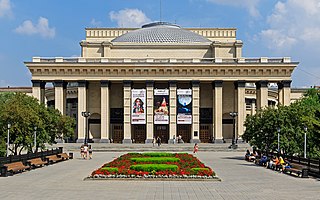
Novosibirsk is the largest city and administrative centre of Novosibirsk Oblast and the Siberian Federal District in Russia. As of the 2021 census, it had a population of 1,633,595, making it the most populous city in Siberia and the third-most populous city in Russia after Moscow and Saint Petersburg. It is also the most populous city in the Asian part of Russia. Novosibirsk is located in southwestern Siberia, on the banks of the Ob River.

Sterlitamak is the second largest city in the Republic of Bashkortostan, Russia, located on the left bank of the Belaya River, 121 kilometers (75 mi) from Ufa. The city's name comes from the Bashkir language and literally means "mouth of the Sterlya river". According to data released by Bashstat, Sterlitamak had a population of 277,410 at the time of the census. Permanent population of Sterlitamak as of January 1, 2023 amounted to 279,174 people.

Haisyn or Haysyn is a city in central Ukraine. It serves as the administrative center of Haisyn Raion within Vinnytsia Oblast. It is located on the Sob in the eastern part of the historical region of Podolia. Its population is 25,698.

Menzelinsky District is a territorial administrative unit and municipal district of the Republic of Tatarstan within the Russian Federation. The district is located on the right bank of the Kama River, in the north-eastern part of the Republic of Tatarstan. The administrative center is Menzelinsk.

Maximilian Alexeyevich Kravkov was a Russian writer, geologist and explorer of Siberia.
The following is a timeline of the history of the city of Novosibirsk, Russia.
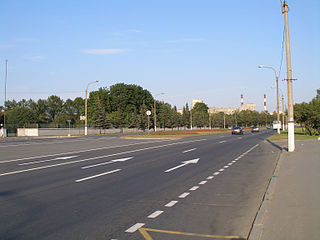
Prospekt Nepokoryonnykh is a street in the northeast of Saint Petersburg, Russia, in Kalininsky District of the city.

Zheleznodorozhny District is an administrative district (raion) of Central Okrug, one of the 10 raions of Novosibirsk, Russia. The area of the district is 8.3 km2. Population: 64 972 (2017).

Novonikolayevsk Resettlement Center is a center for assistance to migrants, opened in 1895. It was located on the territory of modern Zheleznodorozhny City District of Novosibirsk, Russia.

Vladimir Ippolitovich Zhernakov was a merchant, public figure and politician in the Russian Empire and the Soviet Union. The first city head of Novonikolayevsk from 1909 to 1914.

Trams in Irkutsk form the main surface transport network in Irkutsk, the capital of Irkutsk Oblast, Russia. The tramway was founded in 1947 and currently operates 7 lines.
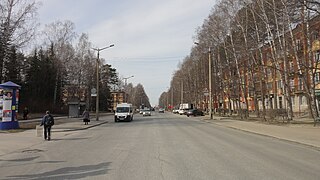
Morskoy Prospekt or Morskoy Avenue is a street in the Akademgorodok of Novosibirsk, Russia. It is one of the central streets of the science city. The prospekt starts from the intersection with Academician Lavrentyev Avenue and Tereshkova Street, runs south-west and then forms a crossroad with Berdskoye Highway. Berdskoe Highway, a narrow strip of forest and a railway line separate it from the bank of the Novosibirsk Reservoir, popularly known as the Sea of Ob', hence the name.

Kryukov House is a building in Zheleznodorozhny City District of Novosibirsk, Russia, built in 1908. It is located on the corner of Sovetskaya and Gorky streets. The house originally belonged to the merchant Zakhary Grigoryevich Kryukov.
Sugar Riot was a riot that occurred in Novonikolayevsk, Russia, on 9 November 1916. The unrest was the result of shortage of sugar.
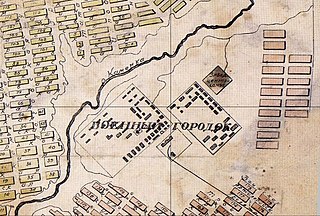
The Military Town is a building complex in Oktyabrsky District of Novosibirsk, Russia. It was built in 1910–1913. New buildings also appeared during the Soviet period.

Zhernakova House is a building in Tsentralny City District of Novosibirsk, Russia. It was constructed in 1912. The house is an architectural monument of regional significance.

The Novosibirsk bus system is part of the public transport network of Novosibirsk, Russia. The system was launched in 1923.

"Taghiyev’s Theater" is the first theater in Baku. It was built in 1883 at the expense of the industrialist and philanthropist Haji Zeynalabdin Taghiyev. It staged both national plays and operas, as well as the works of the world classics. Here, in January 1908, the premiere of the first Azerbaijani national opera "Leyli and Majnun", by Uzeyir Hajibeyov, took place.
Novonikolayevsk City Police Department (NGPU) was a law enforcement organization in Novonikolayevsk, Russian Empire, that existed from 1903 to 1917.
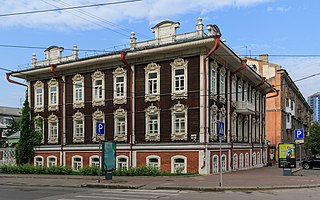
Women's Gymnasium of P. A. Smirnova was an educational institution founded in Novonikolayevsk in 1905 as a school of the 2nd category. In 1907, the educational institution was reorganized into a women's school of the 1st category, and in 1910 it was transformed into a women's gymnasium. Since 1916, the institution has been officially known as The First Novo-Nikolayevsk Gymnasium of the Ministry of National Education.


















